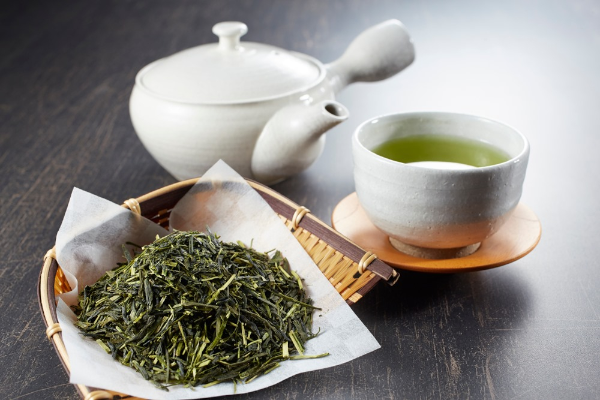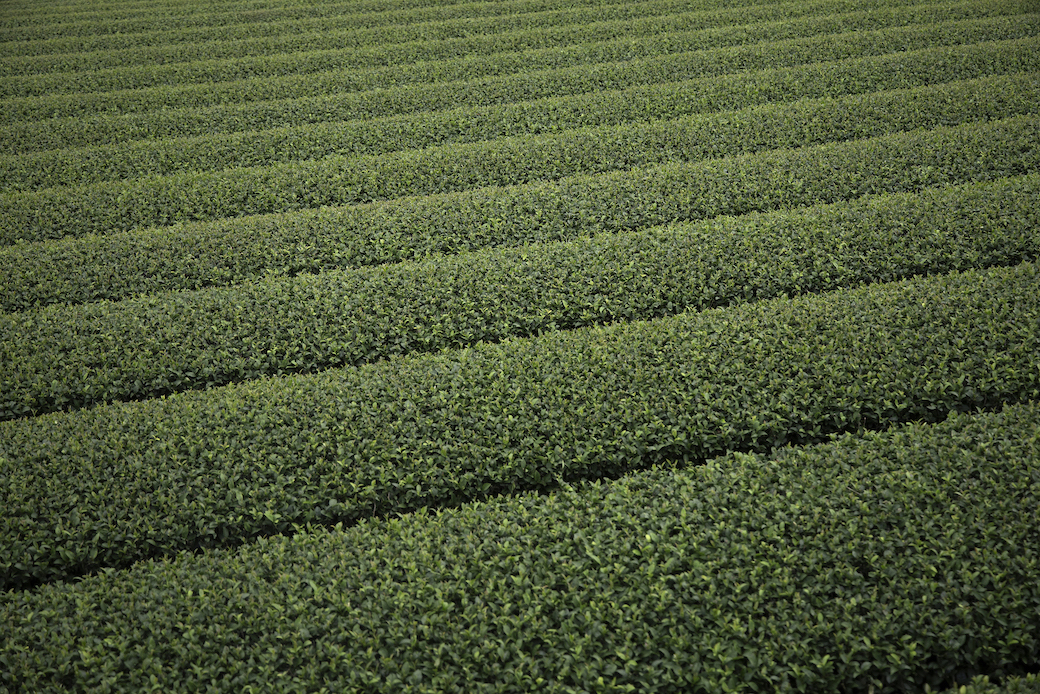Think all green teas are the same?
Nope – that would be like saying all beers are the same. The varieties are diverse, complex and regional.
Even just among Japanese green teas, you’ll find a myriad of teas that are unique in flavor, prolific in their variety, creative in their production and include many of the world’s very best.
From sencha to matcha, let’s take a look at the green teas Japan has to offer. You may just find your new favorite perfect cup.
About Japanese Green Teas
Matcha is the perfect example of the appeal of Japanese tea exploration.
Only a few years ago, it was a specialist choice and offbeat: the only tea where you ingest the tea leaves themselves, ultra-expensive, requiring a whisk, scoop and other tools of the Tea Ceremony ritual and specially-ground using milling stones that take an hour to reduce 30 grams of leaves (around an ounce) to a fine powder. Matcha was very much a hidden treasure.
Other Japanese teas, such as kabusecha and shincha, still largely remain hidden. Historically, only 2% of Japan’s substantial tea production, the 8th largest in the world, is exported.
You have to seek out most of them; they don’t wave at you from the supermarket shelf.
Important fact: the best varieties of Japanese teas are finicky in brewing, with their narrow gap between just right and absolutely awful. Whereas most China and India teas are steeped for several minutes, a fukamushi sencha gets just 45 seconds before it starts becoming bitter and an asamushi sencha a whole minute.
Types of Japanese Green Tea
Here’s a brief introduction to Japanese Green Teas:
Sencha
The classic Japanese green tea. It’s the freshness of taste and savory umami flavor that make a fine sencha. These come from how young and hence tender the buds are.
Individual regions add their own flavors and production strengths. The Uji region is most noted for high-quality sencha. Rephrase that: Uji senchas range from excellent to spectacular.

Gyokuro
Treat yourself, but be very, very attentive to the brewing. This is one of the highest quality teas in the world, also known as “jade dew.” Its distinctive rich fragrance and expansive flavor come from being coddled by covers that shield it from sunlight as it comes close to being harvested. That plus the meticulous hand selection of buds. Plus the terroir. Plus the labor- and skill-intensive artisan processing at every stage from cultivation to maturing.
Genmaicha
“Popcorn” tea. Sencha with roasted brown rice added. The sugar and starch in the rice add a mild and sweet nuttiness. It evolved as a filler for the tea that was unaffordable by poorer families. It remains popular as easy to drink and stomach-friendly. Higher quality genmaichas blend in matcha powder.

Kukicha
Made from the stems and twigs of the plant – what’s otherwise the waste product of tea manufacture. They’re generally processed exactly as the green tea leaves would be, including in the steaming step to finish them. While there are a number of varieties of kukicha, they generally produce a light cup with slightly nutty undertones to a light green tea flavor.
Houjicha
Roasted in a porcelain pot over charcoal, replacing the typical vegetative undertones of Japanese green teas with a toasty flavor that’s been described as caramel-like. It is growing in popularity outside Japan and could well build a strong niche among tea lovers. It has all the appeal of green teas without the grassy notes that some find off-putting.
Kabusecha
The only sencha that is shade – not sun – grown. One to two weeks before harvesting, the plants are covered to block off any sunlight. This produces a mellower sencha. It’s an excellent tea, comparable to and less pricey than gyokuro, which is shaded for about half the time of kabusecha. It has the merits of fine sencha, too, but is sweeter, less grassy and more vegetal.
Shincha
The first picked leaf of the season, higher in the amino acids that give sencha a fresh taste, lower in caffeine and the chemical catechin compounds that add astringency. It’s sweet and grassy in flavor. Good luck finding it and even better luck affording it. It can be quite pricey.
Bancha
Also known as “common tea.” A lower grade of sencha harvested in the summer and autumn. It includes coarser, larger leaf and stems discarded for making sencha. Try it if you are looking for a brisk tea you can drink through the day that is inexpensive and a green tea equivalent of mass-market black tea bags. Otherwise, don’t bother.
Variety and quality of Japanese green teas
Throughout its thousand-year history, Japanese tea growing has been marked by precision, innovation, efficiency, reduction of waste and creation of many flavors from a narrow range of cultivars – varieties of the tea plant.
75% of the acreage of the country’s tea fields grow the hardy yabukita clonal bush that was developed in the 1950s. 80% of the harvest goes to make sencha. Sencha in turn provides the base for several of Japan’s other premium teas.
Hybrid cultivars bred from yabukita and other combinations of seedlings tailor the bushes to regional soil, climate and harvesting methods and add subtle additions to flavor and aroma.
For you, this translates to a mini-cornucopia of choices; it’s easy to find twenty first-rate senchas, all of which offer something a little special.
The Japanese green tea-making process
The major characteristic of green teas is that – unlike black teas and oolong teas – they are not oxidized.
Oxidation is the interaction between the leaf’s thousands of molecular compounds with oxygen. Blocking it releases amino acids and builds up the catechins that give green tea its light flavors and many of its health benefits. Full oxidation builds the tannins that provide the body and astringency of black teas.
The core difference between Chinese and Japanese green teas is that Chinese tea growers arrest oxidation by pan-frying the harvested crop. Japanese methods steam it, typically for just 20-40 seconds.
This produces very small leaves that are beaten, kneaded, agitated, rolled and then straightened to form bright green needle shapes. This stimulates fast and smooth release of flavors in brewing, together with “umami.” This is a brothy, savory vegetal taste that lingers in the mouth and on the tongue. It is now recognized as the fifth taste group, adding to sweet, sour, bitter and salty.
How Japanese green teas are different
Both Japan’s steam-dried and China’s pan-fried teas span a wide range of styles, flavors, aromas, aftertaste and textures so that generalizations are of dubious value.
Here’s one, anyway… Japanese greens are smooth and their taste comes to you cleanly and clearly. China’s are more multidimensional and you need to bring attention and discrimination to find their subtleties. There are an estimated 600 green tea cultivars producing green tea in China: just one dominates Japan’s.
This all suggests a narrow unidimensionality among Japanese teas: one varietal (yabukita), one processing method (steaming), one type (sencha) and one leaf (needles). Far from it.
The single base green tea is differentiated by nuances through seasonal timings of harvests across its microclimates, the number of seconds of “kill-fixing” oxidation, and refining the base crop output to create the premium categories.
There are two divergent paths for the highest-end teas: sun-grown and shade-grown. Covering the bushes weeks or days before the bushes are ready for harvesting shades them from sunlight radiation to bring out chlorophyll and loads the leaf up with l-theanine, one of the wonder compounds of tea that is proven in its relaxing and calming impacts on mood and on alpha/beta brain waves. The two main shade teas are gyokuro and matcha, both derived from sencha.
Japanese green tea grower regions
Tea is grown throughout Japan, with four large prefectures dominating the market and twenty areas of note within them. They are brands in themselves, rather like, say, Burgundy for wines or Parma ham.
Shizuoka: Produces 40% of Japan’s output, mostly sencha. Stronger flavors from its brisk coastal climate and hilly terrain. Very advanced in research, mechanization and production methods. Equally reputed for tea range and quality.

Kagoshima: In the far south on the island of Kyushu. The second-largest producer, with the broadest variety of teas. The climate is warm and humid for most of the year and enables five harvests. Kagoshima teas are fuller and richer in taste than those of most other regions. Increasingly producing some of the most interesting local teas. One of the best options for the shopper: good quality. Reasonable prices and accelerating innovation.
Uji: In the Kyoto Prefecture, the historical center of tea growing in Japan. Produces superb senchas, gyokuro and matcha. Just 3% of Japanese production. Highest reputation for matcha. Superb sencha. Wonderful gyokuro.
Fukuoka: Produces half of Japan’s gyokuro. The Yame area’s Competition grade will shiver your credit card at $50 an ounce: $4 a cup. Happy birthday? Or quick visit to Japan – there is extremely little distribution abroad.
Shopping for value
Just a few years ago, shopping for Japanese teas in the US was very much hit and miss and remains so in Europe and even Asia. The domestic market is undergoing major shifts, most notably a shrinking in acreage and the aging of the smallholder farmers who have been the producers of the best specialty teas; their children are not taking over and the labor pool is moving to urban areas and better jobs.
As in the UK, traditional teas are losing out to flavored and ready to drink beverages, coffee, and convenience; vending machines have become a primary distribution outlet for teas, for example.
There’s a pervasive drift to large farm production, standardization and cost-cutting. Too much matcha, for instance, is poor quality culinary grade grown in China, not the competition-grade that makes for an outstanding premium tea.
Price competition at the expense of quality is creeping up. When you see a China sencha on Amazon selling for less than a teabag of dust, it’s not surprising it’s rated one-star only.
There are, though, plenty of fine teas and fine sellers. The brands best known for upmarket blends and specialty teas offer excellent sencha, houjicha and kukicha, though gyokuro and kabusecha are mostly made by small growers and sold online abroad.
If you have a favorite tea brand, check to see if the firm offers a sencha with pedigree – especially an elite growing region – and artisan production. That shows its general standards that will apply to its matcha, hojicha and other specialties.
Final Thoughts
It may seem naïve or even silly recommendation but is in practice a useful sorting rule: look for passion. The growing small business tea community is marked by an evangelist energy: customer education, collaborative relationships with small farmers, wellness messages, and social improvements in the local communities.
One byproduct of this is that they are knowledgeable and anxious to communicate their expertise. For you to become skilled in buying Japanese teas, you need a reliable, informed enthusiast in selling it.
A final note, on health benefits. Japanese teas are high on the molecular compounds – antioxidants, catechins, EGCG, etc. – that make green tea of such potential across medicine. Matcha and shade-grown varieties add l-theanine, the amino acid of proven therapeutic impact.







